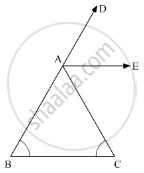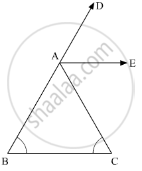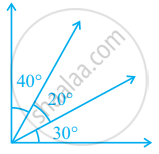Advertisements
Advertisements
प्रश्न
In the given figure, AE bisects ∠CAD and ∠B= ∠C. Prove that AE || BC.

उत्तर
In the given problem, AE bisects ∠CAD and ∠B = ∠C
We need to prove AE || BC

As, ∠CAD is bisected by AE
∠CAD = 2∠CAE - 2∠DAE ..........(1)
Now, using the property, “an exterior angle of a triangle in equal to the sum of the two opposite interior angles”, we get,
∠CAD ∠B +∠C
∠CAD = 2∠C (∠B = ∠C)
2∠CAE = 2∠C (using 1)
∠CAE = ∠C
∠CAE = ∠ACB
Hence, using the property, if alternate interior angles are equal, then the two lines are parallel, we get,
∠CAE = ∠ACB
Thus,AE || BC
Hence proved.
APPEARS IN
संबंधित प्रश्न
The angles of a triangle are arranged in ascending order of magnitude. If the difference
between two consecutive angles is 10°, find the three angles.
The bisectors of base angles of a triangle cannot enclose a right angle in any case.
Can a triangle have All angles less than 60° Justify your answer in case.
Is the following statement true and false :
Sum of the three angles of a triangle is 180 .
Is the following statement true and false :
All the angles of a triangle can be equal to 60°.
State, if the triangle is possible with the following angles :
20°, 70°, and 90°
State, if the triangle is possible with the following angles :
60°, 60°, and 50°
The length of the three segments is given for constructing a triangle. Say whether a triangle with these sides can be drawn. Give the reason for your answer.
7 cm, 24 cm, 25 cm
The length of the three segments is given for constructing a triangle. Say whether a triangle with these sides can be drawn. Give the reason for your answer.
15 cm, 20 cm, 25 cm
The number of angles in figure is ______.
